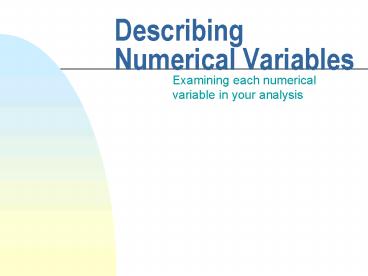Describing Numerical Variables - PowerPoint PPT Presentation
1 / 12
Title:
Describing Numerical Variables
Description:
Describing Numerical Variables. Examining each numerical ... equal interval between values but no true zero point (ex., sociological or ... to recode any ... – PowerPoint PPT presentation
Number of Views:20
Avg rating:3.0/5.0
Title: Describing Numerical Variables
1
Describing Numerical Variables
- Examining each numerical variable in your analysis
2
Numerical Variables
- Variables measured with meaningful numerical
values. - Ratio
- True zero (ex., weight, height, age)
- Interval
- equal interval between values but no true zero
point (ex., sociological or psychological scales) - Discrete
- Values can only take whole numbers as values
- Continuous
- Values have no real breaking point
- Have infinite number of possible values
3
Univariate Analyses with Numerical Variables
- Measures of Central Tendency
- Mean the arithmetic average
- Mode the most popular/common value of response
- Median the value at which 50 of the cases lie
above or below - Measures of Dispersion
- Range the distance between the highest and
lowest value in the variable. Include minimum
and maximum value of variable. - Variance how much values for a variable vary
from the mean. Sum of the squared deviations
from the mean - Standard Deviation the square root of the
variance is typically used to evaluate the
dispersion of cases around the mean. - Skewness how evenly/symmetrically the cases are
distributed around the mean.
4
Steps for Conducting a univariate analysis of
numerical variables
- Calculate the range.
- Order all of the cases for your numerical data
from hi to low values. Take the maximum value
and subtract from it the minimum value. The
result is the range. - Calculate the mean.
- Sum together the values for all cases and then
divide by the total number of cases (?(xi X)/n) - Calculate the median
- Ordered cases from high to low. It is the point
value where half the cases lie above and half
below it.
5
Steps for Conducting a univariate analysis of
numerical variables
- Calculate the mode.
- Ordered cases from high to low, select the most
common value. - Calculate the variance
- For each case, take the value and subtract the
mean from it. Take this result and square it.
Take and sum the squared deviations for all cases
of the variable. Divide the result by the number
of cases. (?(xi X))2/n) - Calculate the standard deviation
- The square root of the variance
- Create a histogram
- A graph which plots the frequency for values of
the variable. The x axis is the value of the
values for the variable. The y axis is the total
number of cases.
6
Once completed the steps for univariate analysis
- Examine each variable for skewness,
- case distributions across values
- outliers
- decide if need to recode any variable
- Decide which measure of central tendency best
describes your variable. Means are not very
useful for skewed distributions.
7
A created sample dataset
8
Using Example to Calculate Range of Age
- Arrange cases fro hi to lo values.
- Find the minimum value
- 18
- Find the maximum value
- 65
- Subtract the maximum from the minimum.
- 65-18 47
9
Using Example to Calculate Mean Age
- Sum all values for all cases
- 18202130323645526065 379
- Divide by the total number of valid cases
- 379/10 37.9
10
Using Example to Calculate mode and Median of Age
- What is it the mode?
- What is the median?
- 323668/234
11
Using Example to Calculate Variance
- Subtract the mean from the value
- Square the result
- Sum the squared deviation
- 396.01320.41285.61
- 62.4131.3636.150.41
- 198.81488.41734.41
- 2603.94
- Divide the result by the total number of cases
- 2603.94/10260.394
S 16.14
12
Using SPSS Short Assignment
- Follow along the exercise in Assignment 2 of
Ready, Set, GO Text. - Use the Frequency procedure
- Get frequencies for all of your categorical
variables - Get range, mean, median, mode,standard deviation
and variance - Use the Charts command to get histograms for all
of your variables - Discuss results for each variable spread,
skewness, best measure of central tendency,
frequency distribution - Turn in by next Tuesday.
- This will be the first part of the results for
Project 2.































